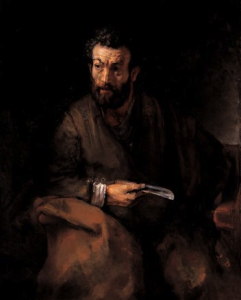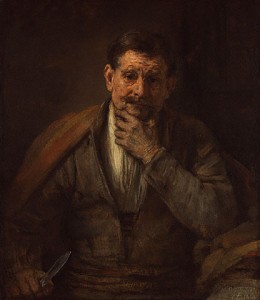I had an incredible experience at the Minneapolis Institute of Arts (MIA) Rembrandt display. I ended up spending three hours with the exhibit and I intend to go back.
Two pieces that I had never seen before were Rembrandt’s portrayals of St. Bartholomew (Commemoration on August 24). There are at least two other portrayals of St. Bartholomew done by Rembrandt, but, I am going to use the two that were on display. I was fascinated. They were not displayed side by side, but, I could sit in one spot and be able to take in both of them. They are beautiful paintings, but what really struck me is the way in which Rembrandt portrays the same person at different ages.
Both of these paintings were painted by a mature Rembrandt, The first one below is from 1657 and the second was painted in 1661, just eight years before Rembrandt’s death. In his early paintings, Rembrandt reflected a lighter approach with his paintings, almost showing a sense of humor, but, as he aged, Rembrandt moved toward showing the deeper pensive side of the person being painted. Rembrandt portrays the transitions of aging; not only physically, but emotionally and spiritually.

I was struck by how Rembrandt illustrated for me Richard Rohr’s view of the male spiritual journey. (Richard Rohr and Joseph Martos, The Wild Man’s Journey – Reflections on Male Spirituality. Cincinnati: St. Anthony Messenger Press, 1996). Rohr describes the journey from warrior to a time of crisis as one realizes the limitations of life. The male on the journey at this time of crisis has the choice: transition to what Rohr calls the “angry old man” or “the holy fool,” one who has matured and gives back. The holy fool is one who has embraced his whole self, both deep masculine and deep feminine, in order to transition into being the wise grandfather who mentors the next generation of men. One does not transition to being the holy fool without a time of deep reflection.
These two paintings contrast for me the journey through the first and second half of life as explored by psychologist Carl Jung and currently applied to the spiritual journey by Fr. Richard Rohr in his book, Falling Upward: A Spirituality for the Two Halves of Life. When I try to draw Rohr’s two books together, I think in terms of the “Warrior” as the first half of life and either the “Holy Fool” or “Bitter Old Man” in the second half of life. The choices made in the pivot point of the time of crisis really do determine whether or not one can successfully transition or if one gets stuck.

In a recent devotion by Richard Rohr, he writes: “Remember this: no one can keep you from the second half of life except yourself. Nothing can inhibit your second journey except your own lack of courage, patience, and imagination. Your second journey is all yours to walk or to avoid. My conviction is that some falling apart of the first journey is necessary for this to happen, so do not waste a moment of time lamenting poor parenting, lost jobs, failed relationships, physical handicaps, gender identity, economic poverty, or even the tragedy of abuse. Pain is part of the deal. If you don’t walk into the second half of your own life, it is you who do not want it. God will always give you exactly what you truly want and desire. So make sure you desire, desire deeply, desire yourself, desire God, and desire everything good, true, and beautiful.” (Center for Action and Contemplation <cac@cacradicalgrace.org, Daily Meditation: Falling Upward — August 18, 2012)
The only caveat that I would offer to Fr. Rohr’s comment is that I believe in the second half of life, as we journey spiritually, we learn to live in the mind of Christ. As we sit before the Word in prayer, God transforms our minds that our desires and God’s desires may be one. Am I still a sinner? Yes. Am I forgiven and renewed? YES. So, in the second half of life, I can become freed to live all that God has given me in the abundant life promised in Jesus Christ.
Rembrandt portrays this journey in his paintings and reflects the transformation that comes in the transition of aging. Rembrandt was going through his own personal crisis when these paintings were done. I believe the paintings reflect his own journey. As I contemplate the paintings in my own life, I have a strong sense that they portray portions of my journey as well.



